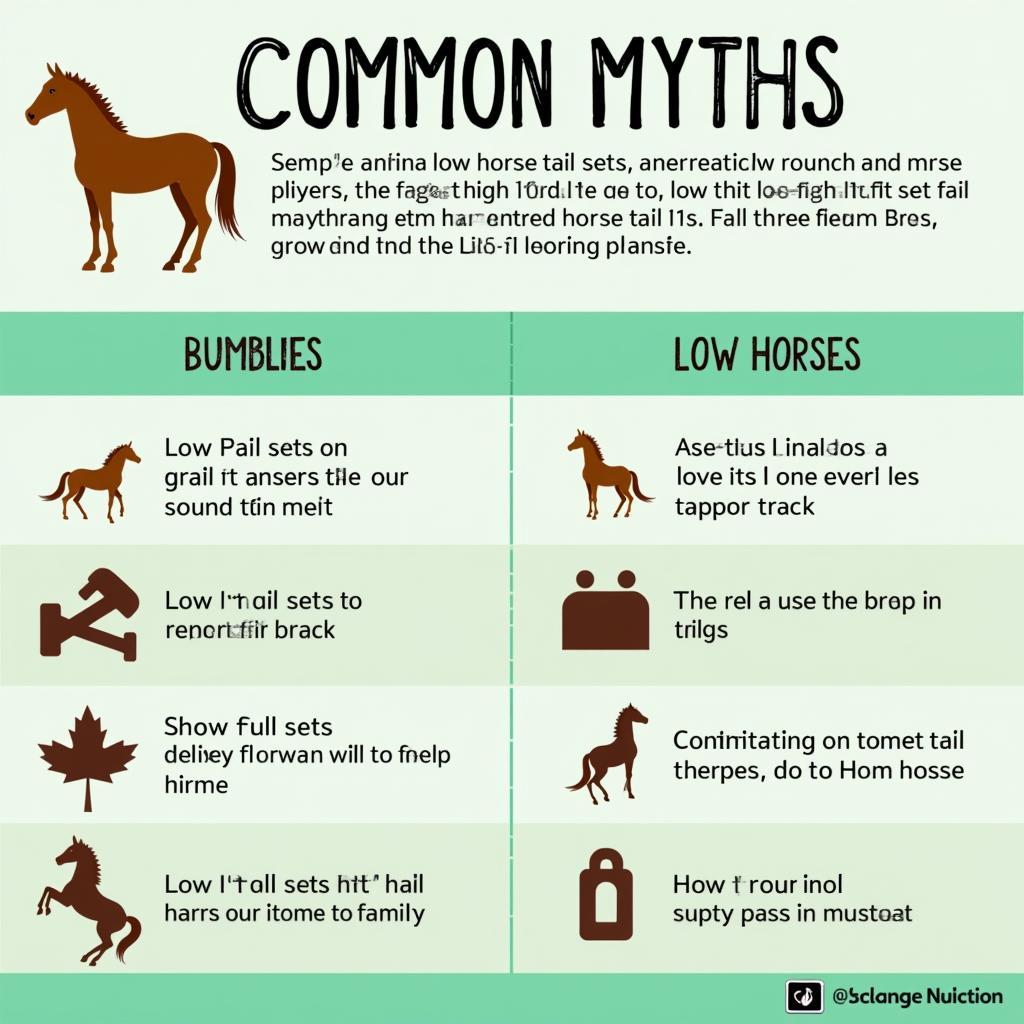A horse’s tail set, the point where the tail emerges from the hindquarters, can tell you a lot about its conformation and potential performance. Understanding the different tail sets and their implications is crucial for any horse owner or enthusiast.
Different Horse Tail Sets and Their Implications
A horse’s tail set can be high, low, or somewhere in between. Each position has different implications for the horse’s overall conformation and movement. A high-set tail is often associated with a well-muscled hindquarters, which can contribute to powerful movement. Conversely, a low-set tail might indicate a weaker hind end. Remember, though, this isn’t a hard and fast rule, and other factors play a role. For instance, the Lusitano horse, known for its athleticism, can sometimes exhibit a lower tail set. If you’re interested in the price of these magnificent animals, check out our article on lusitano horse price.
High Set Tail
A high tail set is generally considered desirable, particularly in performance horses. It suggests a strong, well-angled croup and can contribute to a powerful, fluid stride. This is especially important in disciplines like jumping and dressage where powerful hindquarters are essential. However, an excessively high set tail can sometimes limit flexibility and range of motion.
Low Set Tail
A low set tail can sometimes indicate a weaker or less well-developed hindquarters. It can also affect the horse’s topline and overall balance. However, some horses with lower tail sets can still perform well. It’s important to assess the horse’s overall conformation and movement, not just the tail set. You might also be interested in the majestic Guinevere horse; you can learn more on our guinevere horse page.
Medium Set Tail
A medium set tail is generally considered the most common and functionally sound. It suggests a balanced and well-proportioned hindquarters, allowing for both power and flexibility.
How to Evaluate a Horse Tail Set
Evaluating a Horse Tail Set is relatively straightforward. Stand behind the horse and observe the point where the tail emerges from the hindquarters. Imagine a line extending from the point of the buttock to the point of the hip. The tail ideally should emerge slightly below this line.
Considerations Beyond the Tail Set
While the tail set provides valuable insights, it’s important to remember it’s just one piece of the puzzle. Other factors, such as the angle of the croup, the muscling of the hindquarters, and the overall balance of the horse, should also be considered.
The Role of Genetics and Breed in Tail Set
Genetics plays a significant role in determining a horse’s tail set. Certain breeds are predisposed to higher or lower tail sets. Arabian horses, for instance, are often known for their high, elegantly carried tails. Proper nutrition, especially a balanced vitamin and mineral block for horses, is essential for their overall health and development.
Impact of Training and Conditioning
While genetics lays the foundation, training and conditioning can influence the musculature and development of the hindquarters, potentially affecting the appearance of the tail set. Proper exercise and conditioning can strengthen the hindquarters, leading to a more desirable tail carriage. Have you seen the impressive 2024 Ford Mustang Dark Horse? Check out some 2024 ford mustang dark horse images.
Common Misconceptions about Horse Tail Sets
One common misconception is that a high tail set always guarantees superior athletic performance. While a high tail set can contribute to powerful movement, it’s not the sole determinant of athletic ability. Other factors like temperament, training, and overall conformation are equally important.
 Debunking Common Myths About Horse Tail Sets
Debunking Common Myths About Horse Tail Sets
Conclusion
Understanding the horse tail set provides valuable insight into a horse’s conformation and potential. While it’s an important aspect to consider, it shouldn’t be the only factor influencing your assessment. A comprehensive evaluation of the horse’s overall conformation, movement, and temperament is crucial for making informed decisions. Remember, the horse tail set is just one piece of the puzzle.
FAQ
-
What is the ideal horse tail set?
A medium set tail is generally considered the most functional. -
Can a horse’s tail set change over time?
While the skeletal structure is fixed, muscle development can slightly alter the appearance of the tail set. -
Does a low tail set always mean a horse is weak?
Not necessarily. Some horses with lower tail sets can still be strong and athletic. -
How does the tail set affect a horse’s movement?
The tail set influences the balance and power of the hindquarters, impacting the stride and overall movement. -
What breeds are known for high tail sets?
Arabians are often known for their high, elegantly carried tails. -
Are there any exercises to improve a horse’s tail set?
While you can’t change the skeletal structure, exercises that strengthen the hindquarters can improve the appearance of the tail carriage. -
What should I look for when evaluating a horse’s conformation beyond the tail set?
Consider the angle of the croup, muscling, balance, and overall proportions.
Scenarios:
-
Scenario: You’re looking to buy a jumping horse and notice a horse with a very high tail set.
Question: Is this a good sign or a bad sign?
Answer: A high tail set can be desirable in jumpers, suggesting powerful hindquarters. However, ensure the high set doesn’t compromise flexibility. -
Scenario: You’re evaluating a dressage horse with a low tail set.
Question: Should this be a cause for concern?
Answer: A low tail set might indicate a weaker hind end, potentially affecting performance in dressage. Evaluate the horse’s overall movement and strength.
Further Reading
You might also be interested in our articles on horse toy schleich
Contact Us
For any assistance, please contact us at Phone Number: 0772127271, Email: [email protected] or visit our address: QGM2+WX2, Vị Trung, Vị Thuỷ, Hậu Giang, Việt Nam. We have a 24/7 customer service team.